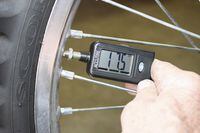Maintenance-savvy motorcyclists appreciate a tire-pressure gauge that's accurate, easy to use and can slip into a jacket pocket. Several gauges on the market fit that description, but this little digital one not only fills that need to a T, it offers a secondary function: It measures tire tread depth. The Tire Pressure & Tread Depth Gauge (part #44402; $16.99) from Griot's Garage (www.griotsgarage.com) is powered by a 3-volt watch battery, is 3 x 1½ x 13∕16-inch in size, weighs just over an ounce and has an LCD readout that displays information in ¾-in.-tall digits. It can measure pressures in either psi, kg/cm2, kPa or bar, and it comes with a zippered, hard-shell fabric carrying case.
Then there’s the tread-depth rod, which can be extended by sliding a little button on the side of the case. When the rod is inserted between tread blocks of a tire, the display shows the remaining tread depth either in fractions of an inch from zero to 19∕32 or in metric values from zero to 15mm. And those numbers work in conjunction with green, yellow and red bars at the bottom of the display. Between 19∕32- (15mm) and 5∕32-in. (4mm), the black bar illuminates to indicate good tread depth. From 4∕32 (3.9mm) to 3∕32 (3.2mm), the yellow bar tells you the tread is at the minimum safe depth. Below those readings, the red bar indicates the need for a new tire.
Most people don’t assess the condition of a bike’s tires with a depth gauge, since the rounded profile of motorcycle tires usually results in uneven wear from the center to the sides. But most motorcyclists also own a car or a truck, and the tread-depth function of this gauge is perfectly suited for measuring the wear on four-wheelers.
Unfortunately, the gauge will not read tire pressures on every bike. Although it is only three inches long, the gauge has a straight (non-angled) fitting, so it requires at least three inches of clearance between the very top of the valve stem and the hub of the wheel in order to fit squarely onto the stem. While most wire-spoked wheels do not present this limitation, some cast wheels do—unless they have been equipped with 90-degree valve stems.

/cloudfront-us-east-1.images.arcpublishing.com/octane/EHHGX7WY6REFLFPN4LWXVC2QP4.jpg)
/cloudfront-us-east-1.images.arcpublishing.com/octane/YNGKWQRUMJEVLL5HTPPAEHIUQA.jpg)
/cloudfront-us-east-1.images.arcpublishing.com/octane/MB5GFVVTBVFY3PFOAQH5CLZTYM.jpg)
/cloudfront-us-east-1.images.arcpublishing.com/octane/R26K447HPJFXNL7HDNAIY4VOI4.jpg)
/cloudfront-us-east-1.images.arcpublishing.com/octane/U3S3JPJT5REW7NTPZMUP2FZY3A.jpg)
/cloudfront-us-east-1.images.arcpublishing.com/octane/WPQ2LXEKPVFZRF2CZLPSDOMVAI.jpg)
/cloudfront-us-east-1.images.arcpublishing.com/octane/BNSDRE4DCJE5ZPOLGPBZPOMZEI.jpg)
/cloudfront-us-east-1.images.arcpublishing.com/octane/GO6FSVIIKNBVPLSIS7IBWE7AEM.jpg)
/cloudfront-us-east-1.images.arcpublishing.com/octane/CS6TMZNTENGKFDW56HSE2HFZ2M.jpg)
/cloudfront-us-east-1.images.arcpublishing.com/octane/FUFID44YDBAM3EHF2AV5LDHLVE.jpg)
/cloudfront-us-east-1.images.arcpublishing.com/octane/QKEXZXUGVFATPE7RAT3HAHDQZ4.jpg)
/cloudfront-us-east-1.images.arcpublishing.com/octane/T7GEMBOUDBHX7EDP2PRQ2J2XME.jpg)
/cloudfront-us-east-1.images.arcpublishing.com/octane/U4CKRUKLKZD43FDSDLZHBL7YVA.jpg)
/cloudfront-us-east-1.images.arcpublishing.com/octane/OFSXJJ5PZFEZ5D5ZPMCFVHJUMA.jpg)
/cloudfront-us-east-1.images.arcpublishing.com/octane/N2JLNLG44VEKBMEPORRDTMX5A4.jpg)
/cloudfront-us-east-1.images.arcpublishing.com/octane/PYWEGG6FHJD6XLPKICS7XHMMZ4.jpg)
/cloudfront-us-east-1.images.arcpublishing.com/octane/XXFQQQ4AYJDCXDGVW3JTHAYONI.jpg)
/cloudfront-us-east-1.images.arcpublishing.com/octane/WMF36OICPZEJDPKABMHQVHXBZ4.jpg)
/cloudfront-us-east-1.images.arcpublishing.com/octane/3DJ46QYFAJA5RIJILQR2XIZXM4.jpg)
/cloudfront-us-east-1.images.arcpublishing.com/octane/4HYMMY6K4JHMNEQ56FXTGAHKG4.jpg)
/cloudfront-us-east-1.images.arcpublishing.com/octane/KUENZXA3RFBIHIDGHEEVH6YNYE.jpg)
/cloudfront-us-east-1.images.arcpublishing.com/octane/UW6THULV65E4TDI4DWLOMDR7LY.jpg)
/cloudfront-us-east-1.images.arcpublishing.com/octane/5S5CDZTZPJBHJBLHENVXEFYKG4.jpg)
